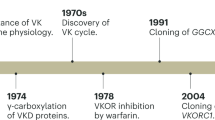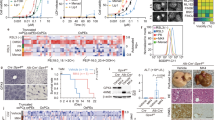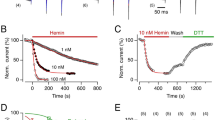Abstract
Vitamin K epoxide reductase (VKOR) generates vitamin K hydroquinone to sustain γ-carboxylation of many blood coagulation factors. Here, we report the 3.6 Å crystal structure of a bacterial homologue of VKOR from Synechococcus sp. The structure shows VKOR in complex with its naturally fused redox partner, a thioredoxin-like domain, and corresponds to an arrested state of electron transfer. The catalytic core of VKOR is a four transmembrane helix bundle that surrounds a quinone, connected through an additional transmembrane segment with the periplasmic thioredoxin-like domain. We propose a pathway for how VKOR uses electrons from cysteines of newly synthesized proteins to reduce a quinone, a mechanism confirmed by in vitro reconstitution of vitamin K-dependent disulphide bridge formation. Our results have implications for the mechanism of the mammalian VKOR and explain how mutations can cause resistance to the VKOR inhibitor warfarin, the most commonly used oral anticoagulant.
This is a preview of subscription content, access via your institution
Access options
Subscribe to this journal
Receive 51 print issues and online access
$199.00 per year
only $3.90 per issue
Buy this article
- Purchase on Springer Link
- Instant access to full article PDF
Prices may be subject to local taxes which are calculated during checkout






Similar content being viewed by others
References
Oldenburg, J., Marinova, M., Muller-Reible, C. & Watzka, M. The vitamin K cycle. Vitam. Horm. 78, 35–62 (2008)
Tie, J. K. & Stafford, D. W. Structure and function of vitamin K epoxide reductase. Vitam. Horm. 78, 103–130 (2008)
Stenflo, J. & Suttie, J. W. Vitamin K-dependent formation of γ-carboxyglutamic acid. Annu. Rev. Biochem. 46, 157–172 (1977)
Furie, B., Bouchard, B. A. & Furie, B. C. Vitamin K-dependent biosynthesis of γ-carboxyglutamic acid. Blood 93, 1798–1808 (1999)
Wajih, N., Hutson, S. M. & Wallin, R. Disulfide-dependent protein folding is linked to operation of the vitamin K cycle in the endoplasmic reticulum. A protein disulfide isomerase-VKORC1 redox enzyme complex appears to be responsible for vitamin K1 2,3-epoxide reduction. J. Biol. Chem. 282, 2626–2635 (2007)
Soute, B. A., Groenen-van Dooren, M. M., Holmgren, A., Lundstrom, J. & Vermeer, C. Stimulation of the dithiol-dependent reductases in the vitamin K cycle by the thioredoxin system. Strong synergistic effects with protein disulphide-isomerase. Biochem. J. 281, 255–259 (1992)
Chu, P. H., Huang, T. Y., Williams, J. & Stafford, D. W. Purified vitamin K epoxide reductase alone is sufficient for conversion of vitamin K epoxide to vitamin K and vitamin K to vitamin KH2. Proc. Natl Acad. Sci. USA 103, 19308–19313 (2006)
The International Warfarin Pharmacogenetics Consortium. Estimation of the warfarin dose with clinical and pharmacogenetic data. N. Engl. J. Med. 360, 753–764 (2009)
Rost, S. et al. Mutations in VKORC1 cause warfarin resistance and multiple coagulation factor deficiency type 2. Nature 427, 537–541 (2004)
Goodstadt, L. & Ponting, C. P. Vitamin K epoxide reductase: homology, active site and catalytic mechanism. Trends Biochem. Sci. 29, 289–292 (2004)
Singh, A. K., Bhattacharyya-Pakrasi, M. & Pakrasi, H. B. Identification of an atypical membrane protein involved in the formation of protein disulfide bonds in oxygenic photosynthetic organisms. J. Biol. Chem. 283, 15762–15770 (2008)
Dutton, R. J., Boyd, D., Berkmen, M. & Beckwith, J. Bacterial species exhibit diversity in their mechanisms and capacity for protein disulfide bond formation. Proc. Natl Acad. Sci. USA 105, 11933–11938 (2008)
Inaba, K. et al. DsbB elicits a red-shift of bound ubiquinone during the catalysis of DsbA oxidation. J. Biol. Chem. 279, 6761–6768 (2004)
Inaba, K. et al. Crystal structure of the DsbB-DsbA complex reveals a mechanism of disulfide bond generation. Cell 127, 789–801 (2006)
Dutton, R. J. et al. Inhibition of bacterial disulfide bond formation by the anticoagulant warfarin. Proc. Natl Acad. Sci. USA advance online publication, 10.1073/pnas.0912952107 (15 December 2009)
Tie, J. K., Nicchitta, C., von Heijne, G. & Stafford, D. W. Membrane topology mapping of vitamin K epoxide reductase by in vitro translation/cotranslocation. J. Biol. Chem. 280, 16410–16416 (2005)
Rost, S. et al. Novel mutations in the VKORC1 gene of wild rats and mice–a response to 50 years of selection pressure by warfarin? BMC Genet. 10, 4 (2009)
Pelz, H. J. et al. The genetic basis of resistance to anticoagulants in rodents. Genetics 170, 1839–1847 (2005)
Rost, S. et al. Site-directed mutagenesis of coumarin-type anticoagulant-sensitive VKORC1: evidence that highly conserved amino acids define structural requirements for enzymatic activity and inhibition by warfarin. Thromb. Haemost. 94, 780–786 (2005)
D’Ambrosio, R. L., D’Andrea, G., Cafolla, A., Faillace, F. & Margaglione, M. A new vitamin K epoxide reductase complex subunit-1 (VKORC1) mutation in a patient with decreased stability of CYP2C9 enzyme. J. Thromb. Haemost. 5, 191–193 (2007)
Silverman, R. B. Chemical model studies for the mechanism of vitamin K epoxide reductase. J. Am. Chem. Soc. 103, 5939–5941 (1981)
Gross, E., Kastner, D. B., Kaiser, C. A. & Fass, D. Structure of Ero1p, source of disulfide bonds for oxidative protein folding in the cell. Cell 117, 601–610 (2004)
Gross, E., Sevier, C. S., Vala, A., Kaiser, C. A. & Fass, D. A new FAD-binding fold and intersubunit disulfide shuttle in the thiol oxidase Erv2p. Nature Struct. Biol. 9, 61–67 (2002)
Gebauer, M. Synthesis and structure-activity relationships of novel warfarin derivatives. Bioorg. Med. Chem. 15, 2414–2420 (2007)
Jin, D. Y., Tie, J. K. & Stafford, D. W. The conversion of vitamin K epoxide to vitamin K quinone and vitamin K quinone to vitamin K hydroquinone uses the same active site cysteines. Biochemistry 46, 7279–7283 (2007)
Bardwell, J. C. et al. A pathway for disulfide bond formation in vivo . Proc. Natl Acad. Sci. USA 90, 1038–1042 (1993)
Bader, M., Muse, W., Zander, T. & Bardwell, J. Reconstitution of a protein disulfide catalytic system. J. Biol. Chem. 273, 10302–10307 (1998)
Kishigami, S., Kanaya, E., Kikuchi, M. & Ito, K. DsbA-DsbB interaction through their active site cysteines. Evidence from an odd cysteine mutant of DsbA. J. Biol. Chem. 270, 17072–17074 (1995)
Malojcic, G., Owen, R. L., Grimshaw, J. P. & Glockshuber, R. Preparation and structure of the charge-transfer intermediate of the transmembrane redox catalyst DsbB. FEBS Lett. 582, 3301–3307 (2008)
Zhou, Y. et al. NMR solution structure of the integral membrane enzyme DsbB: functional insights into DsbB-catalyzed disulfide bond formation. Mol. Cell 31, 896–908 (2008)
Inaba, K. et al. Dynamic nature of disulphide bond formation catalysts revealed by crystal structures of DsbB. EMBO J. 28, 779–791 (2009)
Regeimbal, J. et al. Disulfide bond formation involves a quinhydrone-type charge-transfer complex. Proc. Natl Acad. Sci. USA 100, 13779–13784 (2003)
Otwinowski, Z. & Minor, W. Processing of X-ray diffraction data collected in oscillation mode. Methods Enzymol. 276, 307–326 (1997)
Terwilliger, T. C. & Berendzen, J. Automated MAD and MIR structure solution. Acta Crystallogr. D 55, 849–861 (1999)
Cowtan, K. D. & Main, P. Phase combination and cross validation in iterated density-modification calculations. Acta Crystallogr. D 52, 43–48 (1996)
Zhang, K. Y., Cowtan, K. & Main, P. Combining constraints for electron-density modification. Methods Enzymol. 277, 53–64 (1997)
Sheldrick, G. M. A short history of SHELX. Acta Crystallogr. A 64, 112–122 (2008)
Langer, G., Cohen, S. X., Lamzin, V. S. & Perrakis, A. Automated macromolecular model building for X-ray crystallography using ARP/wARP version 7. Nature Protocols 3, 1171–1179 (2008)
Jones, T. A., Zou, J. Y., Cowan, S. W. & Kjeldgaard, M. Improved methods for building protein models in electron density maps and the location of errors in these models. Acta Crystallogr. A 47, 110–119 (1991)
Emsley, P. & Cowtan, K. Coot: model-building tools for molecular graphics. Acta Crystallogr. D 60, 2126–2132 (2004)
Winn, M. D., Isupov, M. N. & Murshudov, G. N. Use of TLS parameters to model anisotropic displacements in macromolecular refinement. Acta Crystallogr. D 57, 122–133 (2001)
Murshudov, G. N., Vagin, A. A. & Dodson, E. J. Refinement of macromolecular structures by the maximum-likelihood method. Acta Crystallogr. D 53, 240–255 (1997)
Tu, B. P., Ho-Schleyer, S. C., Travers, K. J. & Weissman, J. S. Biochemical basis of oxidative protein folding in the endoplasmic reticulum. Science 290, 1571–1574 (2000)
Acknowledgements
We thank C. Jao for help with mass spectroscopy, S. Harrison for insightful comments on the structure, B. Furie, B. C. Furie and Y. Yu. for discussion, A. Osborne, B. van den Berg, J. Zimmer, and Y. Chen for critical reading of the manuscript, R. Zhang for help with the figures, the staff at Advanced Photon Source beamline ID-24C, and the SBGrid consortium at Harvard Medical School. S.S. is supported by an NIH Medical Scientist Training Program fellowship. J.B. is supported by grant GMO41883 from the National Institute of General Medical Sciences. W. L. is supported by a Charles King Trust fellowship and K99 grant 1K99HL097083 from the National Heart, Lung, and Blood Institute (NIH). T.A.R. is an HHMI investigator.
Author Contributions J.B., R.J.D. and D.B. conceived the project. W.L. purified and crystallized the proteins, and determined the structures. S.S. generated constructs and aided in crystallization. S.S. and W.L. performed biochemical analysis. W.L., S.S. and T.A.R. analysed the data and wrote the paper.
Author information
Authors and Affiliations
Corresponding authors
Ethics declarations
Competing interests
The authors declare no competing financial interests.
Supplementary information
Supplementary Information
This file contains Supplementary Table S1, Supplementary Figures S1- S10 with Legends and Legends for Supplementary Movies 1-2. (PDF 9103 kb)
Supplementary Movie 1
This movie shows the overall structure of the protein, consisting of VKOR (pink) and the thioredoxin (Trx)-like domain (blue) - see Supplementary Information file for full Legend. (AVI 24126 kb)
Supplementary Movie 2
In this movie the active site of VKOR is shown together with the experimental electron density map - see Supplementary Information file for full Legend. (AVI 27723 kb)
Rights and permissions
About this article
Cite this article
Li, W., Schulman, S., Dutton, R. et al. Structure of a bacterial homologue of vitamin K epoxide reductase. Nature 463, 507–512 (2010). https://doi.org/10.1038/nature08720
Received:
Accepted:
Published:
Issue Date:
DOI: https://doi.org/10.1038/nature08720
This article is cited by
-
Nanoparticles and photochemistry for native-like transmembrane protein footprinting
Nature Communications (2021)
-
Sublethal dose of warfarin induction promotes the accumulation of warfarin resistance in susceptible Norway rats
Journal of Pest Science (2021)
-
Disulfide bond formation in prokaryotes
Nature Microbiology (2018)
-
Warfarin traps human vitamin K epoxide reductase in an intermediate state during electron transfer
Nature Structural & Molecular Biology (2017)
-
Warfarin and vitamin K compete for binding to Phe55 in human VKOR
Nature Structural & Molecular Biology (2017)
Comments
By submitting a comment you agree to abide by our Terms and Community Guidelines. If you find something abusive or that does not comply with our terms or guidelines please flag it as inappropriate.



